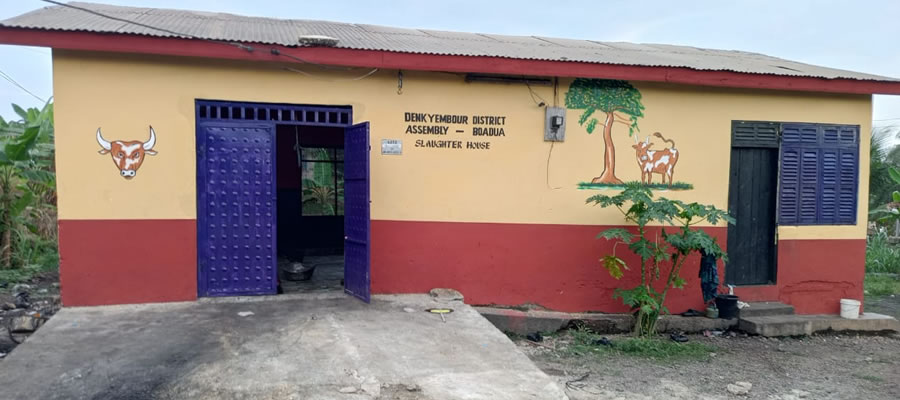

Introduction
Population size, composition and age-sex structures are critical in understanding the fertility, mortality and migration dynamics of any place. Population composition is the description of a population according to characteristics such as age, sex, marital status, ethnicity, education and occupation (2010 PHC). The objective of this chapter is to analyze the size, composition, and age-sex structure of the population of the Denkyembuor District using the 2010 Population and Housing Census data.
Population Size and Distribution
Table 2.1 presents the population size and distribution in the Denkyembuor District. A total of 78,841 people reside in the District. This is made up of 40,027 females who make up 50.8 percent of the entire population whereas the male population is 38,814 representing 49.2 percent. The proportion of the population between ages 15-64 represent 55.9 percent. The age groups 0-14 and 65+ constitute 39.5 percent and 4.6 percent respectively. A little over a fourth (44.1%) of the population is within the dependent age group. For example the age group 0-4 gives a higher proportion of 13.6 percent of the entire population with a slight male dominance. This suggests that there are more males at birth than females in the District.
More than half (57.7%) of the population lives in the urban area. The sex ratio of the District is 96.7 implying that for every 100 female there are 97 males. There is therefore, a predominance of females over males. A possible explanation could be as a result of male leaving the District into other mining areas because of the down turn of the only mining industry in the District.
Age-Sex Structure
The age structure and sex composition of the District indicate a broad base that gradually tappers off with increasing age, and this is similar to the Regional Pattern. Table 2.1 again presents the population by five year age groups by sex for the District. The age-sex structure of the District comprises a concentration of children at younger ages. There are more males than females from age 0-19 but the trend changes with female dominance from age 20 to 39. There is a slight male dominance from age 45 to 64 with females dominating up to age 99. It is observed that there are fewer males from age 20 to 39; this could be due to many leaving the District into other mining areas. The distribution to some extent conforms to the conventional pattern of sex ratio decreasing at advance ages confirming that females live longer than males.
The Age structure of the District suggests a young population. Almost 40 percent of the total population falls within ages 0-14. Children under 5 years constitute 13.6 percent of the District’s total population while 55.9 percent of the population are in the age group (15-64) years . For the age groups (15-64) many are between ages 15-19 making up 11.3 percent. Less than five percent are in the dependent age group (65+). People within age group 70-74 are in the majority. Only 70 persons in the District are within the age group 95-99.
This type of population structure is typical of developing countries where high fertility is accompanied by a high, though declining mortality. The age structure for the sexes also follows the regional pattern where the percentage of male population predominate in the early few years and overtaken by the female population in later years.
Figure 2.1 illustrates the age-sex structure of the District's population and provides insights of the population distribution. The figure indicates a broad base comprising concentration of children at younger ages. For example the age group 0-4 suggests a higher proportion (13.6%) of the entire population with a slight male dominance (51.2%). There are more males than females from age 0-19 but the trend changes with female dominance from age 20 to 39. There is a sharp reduction from 20 -34 and a slight increase from 70-74 and eventually decline from 75-99.
Dependency Ratio
Table 2.1 further shows that, the District has an age dependency ratio of almost seventy nine (78.8) indicating that for every 100 working persons, seventy nine persons depend on them. In the case of the male and female working groups, the dependency ratios are 81 and 76 respectively. Urban dependency (73.7) is lower compared to those in rural areas (86.3).
Fertility, Mortality and Migration
Fertility
Fertility refers to the actual birth performance i.e. frequency or childbearing among a population and fecundity denotes the physiological capacity of a woman, man or couple to reproduce (International Union for the Scientific Study of Population, 1982). The Crude Birth Rate (CBR) is defined as the number of births in a given year divided by the number of people in the population in the middle of that year. The General Fertility Rate (GFR) is the number of births in a given year divided by the mid-year population of women in the age groups 15-44 and 15-49. The Total Fertility Rate (TFR) is the average number of children a woman will have given birth by the end of her reproductive years if current fertility rates prevailed (2010 PHC National Analytical Report).
Table 2.2 shows that TFR varies among the Districts in the Region. A total of 19,644 women aged 15-49 gave birth to 1950 children in the last 12 months prior to census night. The total fertility rate for the District is 3.4. The situation is not very different in many other Districts in the Region except Kwahu Afram Plains South with a total fertility rate at 4.7 and New Juaben Municipal has the lowest of 2.4. Comparing Denkyembuor District to the regional figure, (3.5) it is obvious that fertility is almost the same.
Children ever born and children surviving
Table 2.3 indicates that females 12 years and older in the district gave birth to 71,782 children out of which 63,168 survived. As many as 16 children have ever been born to women aged 12-14, of which ten are males and six are females. Four out of the ten males born to these women died whiles the six females survived. Majority of child births took place between ages 20 - 44. It is observed that female children have a higher survival rate than their male counterparts in the District. For instance, of the 4,934 male children ever born to women aged 40 - 44 in the District, 513 died as compared to 434 females. Only 942 women aged 55-59 gave birth to 5,102 children in their life time, with more males (322) dying compared to 305 females.
Mortality
Table 2.4 depicts mortality trends in the Region. Crude Death Rate (CDR) which is the number of deaths per 1,000 populations. Over all, there were 444 deaths in the District with a CDR of 5.6 which is lower than the regional average of 8.2. This is relatively lower when compared to the crude death rate of 9.6 for Akwapem North and 13.6 for Yilo Krobo Districts. In essence people are living longer in the District than other Districts in the Region except for the Kwahu Afram Plains South District.
Table 2.7 shows the causes of deaths in households by district. From the table, there were 443 deaths in the district. Out of the total deaths in the district, 12.0 percent is caused by accident/violence/homicide/suicide whiles the remaining 88.0 percent deaths are by other causes.
Age Specific death rate
Death rates can also be calculated for specific age groups in order to compare mortality at different ages or at the same age over time. Because mortality varies greatly by sex and race, age-specific death rates (ASDR) are often given separately for males and females and for different racial groups in a population.
Figure 2.2 shows reported age-specific death rate by sex in the district. From the figure, death among children below 5 years is high and drops to about age 9 for both sexes. From age 19, deaths among females are higher compared to males but begin to drop at age 49, where it rises and falls till age 54 where the male deaths rises sharply above that of females.
Migration
The importance of measuring migration lies in its impact on population size, structure and distribution in the region. Emigration or out migration decreases the size of the population in the district, while immigration or in migration increases the population size. In addition, the variations in the migration process in terms of age, sex, education and other socio-demographic characteristics can have significant impact on the overall social and economic development of the district. Migration is difficult to measure due to its repetitiveness and difficulty in establishing direction and permanency of the event. Nevertheless, census information on usual place of residence five years before the census and current residence is used to discuss migration patterns in the district. Migration can be measured in many ways, however, in this section; it is measured with respect to birthplace.
Birthplace and Duration of Residence
The places of birth and duration of residence are important for understanding the movement pattern of the population in any community. Table 2.6 show that 24,738 persons are migrants in the District. Nearly a third (30.1%) of migrants in the District has been residing there for more than 20 years with almost the same proportion (32.4%) staying for less than five years. A considerable number of migrants in the District were born in other localities in another region. Those born in the Central Region constitute the highest with 31.7 percent of migrants, with the Upper East Region recording the lowest of 1.4 percent. Almost 4 out of every 10 migrants from the three northern regions stay for more than a period of 20 years in the district.
Date Created : 11/24/2017 2:25:55 AM













 facebook
facebook
 twitter
twitter
 Youtube
Youtube
 +233 593 831 280
+233 593 831 280 0800 430 430
0800 430 430 GPS: GE-231-4383
GPS: GE-231-4383 info@ghanadistricts.com
info@ghanadistricts.com Box GP1044, Accra, Ghana
Box GP1044, Accra, Ghana